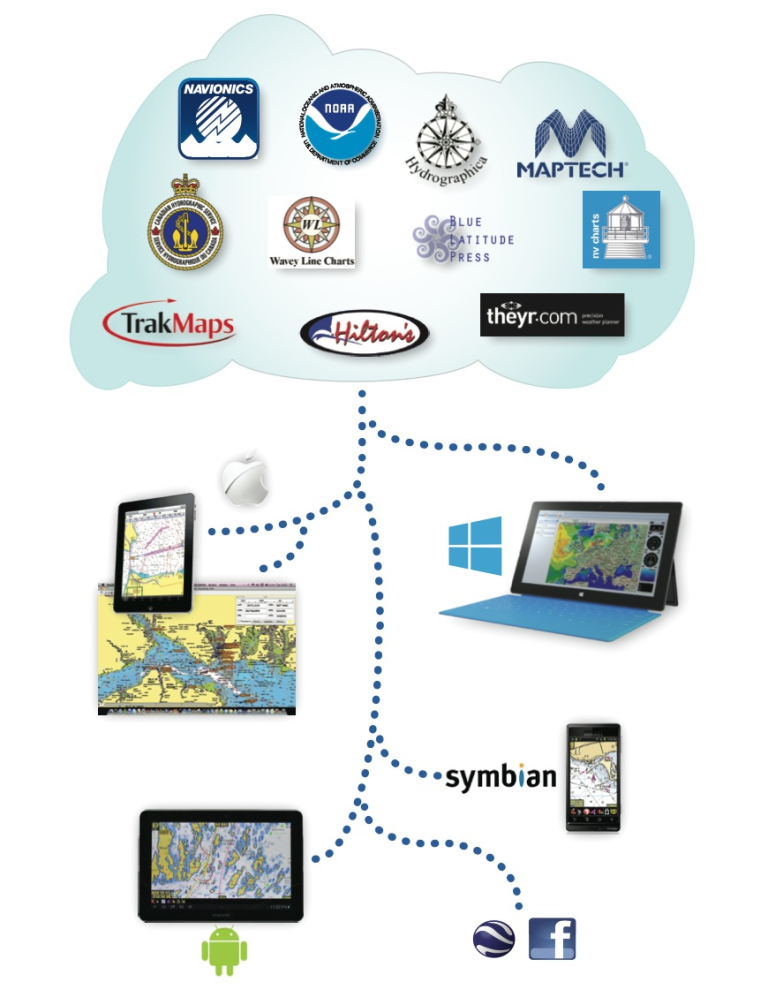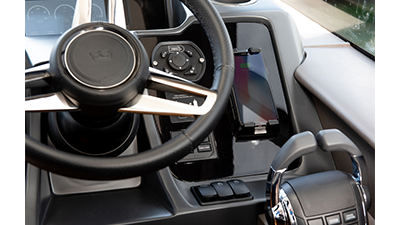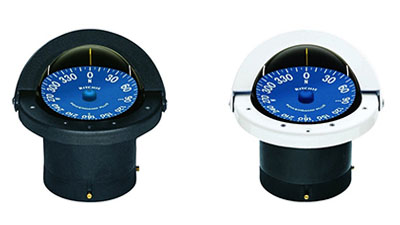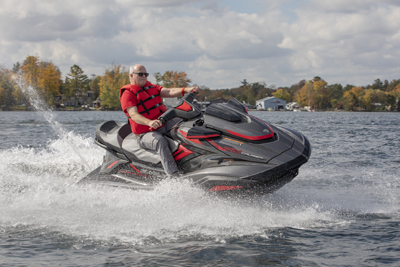Upgrade to a “Sweet Suite” of new electronics

By Andy Adams
You won’t be surprised to hear about all the great features and capabilities available when you upgrade to a new suite of navigation electronics, but you might be surprised at how much functionality you can get at sweet deal prices.
We contacted some of the biggest names in the business; Furuno, Garmin, Simrad, B&G and Raymarine and we interviewed the product managers about the models in their line that represent the:
1. The most affordable
2. Most interconnected
3. Most user-friendly
We realize that more is always more, but we asked the question; what products in their lines offer the sweet deal on functionality and features for recreational cruising on power and sail boats from 21’ to 40’?
When you see some of the prices and what you can get now, it may make sense to go with a whole new system where everything works in concert, delivers the best performance for the money and sets you up to be current for years to come.
To get the “inside scoop” we spoke to the top product people at all the major electronics companies. In alphabetical order, let’s start with Furuno and my discussion with Eric Kunz, 30-year Furuno veteran and Senior Product Manager.
FURUNO
In our conversation, Eric Kunz noted that Furuno is focused on the same priorities of being most user-friendly, most inter-connected and of course, it’s all price competitive across the industry so, most affordable is always important.
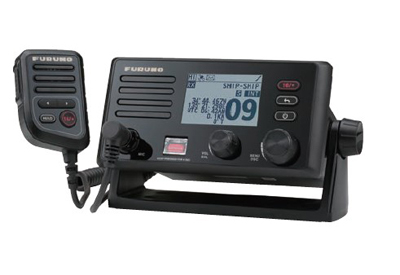 Eric started with the Furuno FM-4800 VHF radio because it includes both GPS and AIS. It’s an affordable VHF for cruisers focused on communications for safety.
Eric started with the Furuno FM-4800 VHF radio because it includes both GPS and AIS. It’s an affordable VHF for cruisers focused on communications for safety.

In the recent NMEA Awards competition, Furuno won the Tech Award for their NavNet TZ Touch3 MFD with a personal bathymetric generator. This allows you to create your own shaded relief maps of the sea floor, so you can easily identify hidden structure that attracts fish. It works with the Furuno Multibeam Sonar. Also, their MFD screens are all moving to edge-swipe technology across the board. It’s simple and fast to use, so very user-friendly. You don’t need to dive deep into menus to find them.
The NavNet TZTouch3 series of MFDs is available in 9”, 12”, 16” and 19” screen sizes (somewhat standard sizing within the industry) and they all have multi-channel capability so for example, you can probably plug and play your old transducer, at least for basic navigation.
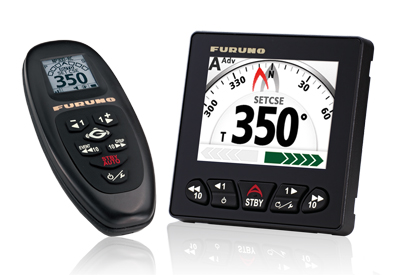 In terms of upgrades and things that could really transform an older boat, Eric suggests adding an AutoPilot system like their Furuno NavPilot 300 with the SafeHelm II add-on for boats with mechanical steering. Running a true course with little effort can make your day more enjoyable and save fuel as well.
In terms of upgrades and things that could really transform an older boat, Eric suggests adding an AutoPilot system like their Furuno NavPilot 300 with the SafeHelm II add-on for boats with mechanical steering. Running a true course with little effort can make your day more enjoyable and save fuel as well.
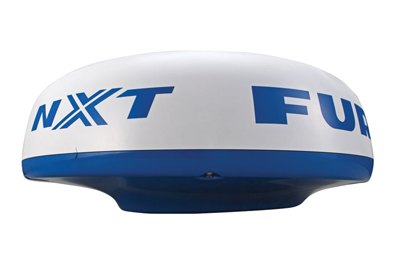
While many may feel that a radar system is high-end, Eric says the Furuno DRS4DNXT has changed how people use radar. Some of the key features are that it is a Solid-State pulse compression Doppler Radar, so there is no pre-heating time, low energy consumption (because there’s no magnetron) and therefore you can run it all the time. The Target Analyzer function instantly identifies hazardous targets and can display them for fast identification.
Visit the Furuno website at https://www.furuno.com/en/
GARMIN
Carly Hysell, Garmin’s Media Relations Manager set us up to interview Dave Dunn, Garmin’s Sr. Director of Marine Sales.
From the top, Dave said usability is key at Garmin. To be user friendly you want to be able to power up and easily work your way through the menus like you would with your iPad or Apps to select navigation, then radar and so on. Dave said a child could run their systems, they are that intuitive.
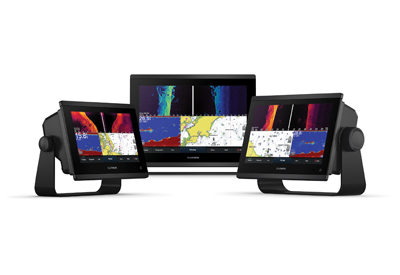 Garmin studies the competitive products and how people adapt to the equipment, and they want their Garmin products to be familiar by all working the same way. Their GPS Map series X3 which comes in 7-inch, 9-inch and 12-inch sizes is an example. Which ever size would work best for your boat and your budget, they will all perform the same way.
Garmin studies the competitive products and how people adapt to the equipment, and they want their Garmin products to be familiar by all working the same way. Their GPS Map series X3 which comes in 7-inch, 9-inch and 12-inch sizes is an example. Which ever size would work best for your boat and your budget, they will all perform the same way.
The Garmin products feature Navionics cartography and there is coverage globally. Garmin bought Navionics four years ago and it’s the world’s biggest cartography supplier. One of the great ways to get weather information is to subscribe to Sirius radio. Cell phone range is limited, but Sirius has a much broader footprint.
From a safety perspective. Dave emphasized that digital selective calling was established long ago, but not enough people are using the DSC features, or features such as AIS. He hopes that the United States and Canada push more people to register for AIS because that system of identification works on all GPS receivers.
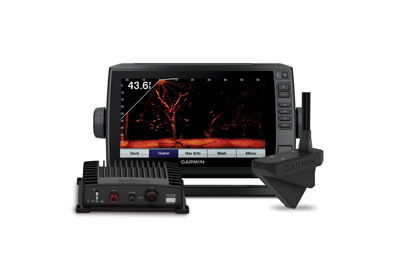 Continuing through the product catalog, Dave recognizes that sophisticated sonar isn’t as important for sailors, but going to the next level, there’s Garmin’s Livescope. The image is so detailed that you can literally see fish swimming around your boat. Livescope is a hot seller in the Great Lakes area – it’s their number one territory for that product.
Continuing through the product catalog, Dave recognizes that sophisticated sonar isn’t as important for sailors, but going to the next level, there’s Garmin’s Livescope. The image is so detailed that you can literally see fish swimming around your boat. Livescope is a hot seller in the Great Lakes area – it’s their number one territory for that product.
Upgrading to an Autopilot is one of the very fastest growing segments in the marine electronics area and Garmin has AutoRouting which lets you create a safe path to your destination including water depths and clearances, so you can safely follow the route on Autopilot. Some other systems take you on a straight line expecting you to navigate islands and channels.
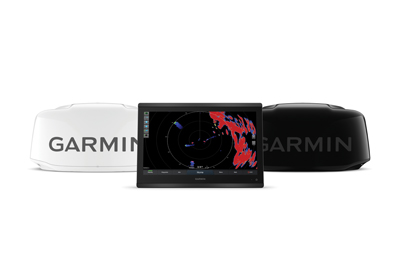 In terms of their most popular products, Garmin offers their GPS Map series in sizes from 7-inch to 24-inch screens and for sophisticated users, or larger boats, they recommend their Fantom Radar (image of Garmin Fantom Radar) with Doppler capabilities. Garmin has simplified the display so a target approaching you alerts in red where a target moving away from you is green. Customers like that sort of simplicity and clarity.
In terms of their most popular products, Garmin offers their GPS Map series in sizes from 7-inch to 24-inch screens and for sophisticated users, or larger boats, they recommend their Fantom Radar (image of Garmin Fantom Radar) with Doppler capabilities. Garmin has simplified the display so a target approaching you alerts in red where a target moving away from you is green. Customers like that sort of simplicity and clarity.
Garmin offers tutorials for their products on YouTube and also on some webinars.
Visit: www.garmin.com
NAVICO Brands – Simrad and B&G
Earlier in 2021, Navico was acquired by the Brunswick corporation to be part of their ever-growing portfolio of diversified marine companies. Brunswick’s Advanced Systems Group is focused on electronics and high-tech and Navico was a brilliant acquisition.
In turn, Navico brings several well-established brands with Simrad, B&G, Lowrance and C-MAP We had the opportunity to speak to Stephen Thomas, product director for Simrad, and Matt Fries business acquisition manager from the B&G side, giving us both a power boat and a sailboat viewpoint in our discussions.
We started by asking how they thought boaters were getting their weather information. Understandably, many people rely on their cell phone for nearshore use, but when you’re out of cellular range, a great alternative is to have the Sirius XM weather package. This satellite service is available in North America. Additionally, their MFDs have the ability to download and view GRIB weather if they have internet connectivity. B&G MFDs also have the ability to perform weather Routing through a partnership with PRedictWind.
Going a step up, Matt Fries pointed out that radar can be used to track and avoid storm cells. They have a dedicated weather mode which will automatically tune the radar to optimize weather detection, and with VelocityTrack Doppler technology, approaching cells are easily identified. It’s ideal for boats in the 35-foot or 45-foot range.
This cartography can be used with any of the Navico family MFDs, but in terms of simplicity and value, the Simrad Cruise, available in 5-inch, 7-inch and 9-inch screen sizes is the most intuitive, easy-to-use chartplotter. Everything you need for simple and straightforward GPS navigation is right inside the box – sunlight viewable display, mounting bracket and a sonar transducer. Simrad Cruise can display charts, navigation and sonar in split-screen view, or separately in full screen. Rotary dial and keypad controls make navigating through menus, creating routes and accessing temperature, speed, depth readings and battery voltage effortless. Prices range from $479 for the basic 5-inch Cruise to $699 for a fully loaded 9-inch screen.
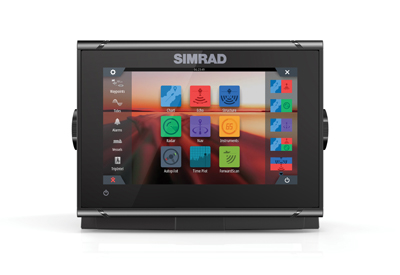 For greater functionality, step up to the Go Series with touch screens from 5-inches up to 12-inches. The GO7 XSR is a great way to expand the capabilities of your sportboat or dayboat. Cruise confidently with C-MAP Discover charts, find fish with built-in sonar, and extend your view with an optional radar system. Wireless connectivity to smartphones and tablets keeps you in control from anywhere onboard.
For greater functionality, step up to the Go Series with touch screens from 5-inches up to 12-inches. The GO7 XSR is a great way to expand the capabilities of your sportboat or dayboat. Cruise confidently with C-MAP Discover charts, find fish with built-in sonar, and extend your view with an optional radar system. Wireless connectivity to smartphones and tablets keeps you in control from anywhere onboard.
Stepping up again is the NSS EVO3S with faster page loading, any choice of split-screen and views in 3D or navigation perspective. Control it all from one screen.
What Stephen Thomas emphasized was to match the tech to the consumer and their experience level; give them the features without overwhelming them.
Matt Fries pointed out that B&G does not have an equivalent to the Simrad Cruise series, but their Vulcan is comparable to the Simrad Go series, then they have the Zeus3S. While the hardware platforms are sometimes shared with Simrad, the B&G software focuses on sailing navigation with features such as Laylines and Sailsteer. Basic sailing characteristics of a vessel can be entered so that trip times and distances account for any tacking and gybing required to get to a destination.
In 1946 Simrad pioneered autopilot and they celebrate their 75th Anniversary this year. Autopilot let’s you take your hands off the wheel to tend to other needs while cruising and it saves fuel as well. Matt Fries explained that upgrading to Autopilot was one of the top “asks” among boat show customers. Simrad Autopilot can come in from $1,300 to $3,600 and they have a “system pack” that varies according to what you have now.
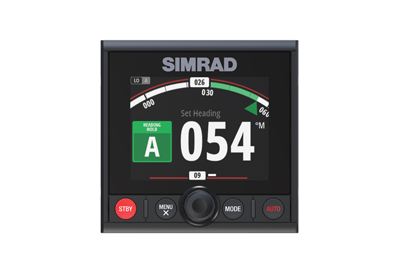 For sailors, B&G offers below decks Autopilot systems for vessels 28-feet and larger starting about $3,000. If you have a smaller boat that can use a tiller pilot, the starting price drops under a grand.
For sailors, B&G offers below decks Autopilot systems for vessels 28-feet and larger starting about $3,000. If you have a smaller boat that can use a tiller pilot, the starting price drops under a grand.
RAYMARINE
We also reached out to Raymarine Marketing Manager James McGowan who responded right away and with the following very concise information.
 Most Affordable: McGowan started with the Element-S with (or without) and Quantum wireless radar. He said the “Element-S is our compact MFD designed for cruising boats. It runs our LightHouse Sport operating system which is a simplified version of what we run on our Axiom MFDs. Element systems are designed for 1-display operation (they don’t network with other big screens) but they do support NMEA2000 networking for connection to AIS, VHF, autopilot, and sailing instruments. We have Element-S units in 7, 9 or 12-inch sizes starting at $524.99 for a 7” unit that includes LightHouse North America charts. It has a built-in sonar as well, and we offer a range of different depth transducers to fit sailboats of all sizes. Element-S is compatible with our Quantum radar for anyone who might need that capability.”
Most Affordable: McGowan started with the Element-S with (or without) and Quantum wireless radar. He said the “Element-S is our compact MFD designed for cruising boats. It runs our LightHouse Sport operating system which is a simplified version of what we run on our Axiom MFDs. Element systems are designed for 1-display operation (they don’t network with other big screens) but they do support NMEA2000 networking for connection to AIS, VHF, autopilot, and sailing instruments. We have Element-S units in 7, 9 or 12-inch sizes starting at $524.99 for a 7” unit that includes LightHouse North America charts. It has a built-in sonar as well, and we offer a range of different depth transducers to fit sailboats of all sizes. Element-S is compatible with our Quantum radar for anyone who might need that capability.”
Most Inter-connected: For inter-connectedness, James McGowan said, “Our Axiom+ family fits nicely here. Axiom+ units come in 7, 9 or 12-inch sizes. (Axiom Pro 12) You can connect multiple displays together if you need access both at the helm (or 2 helms) and down below at your navigation table. These units have fast RayNet Ethernet connectivity, NMEA2000, Wi-FI, and Bluetooth. You can stream them to your mobile device or tablet and fully remote control them with our free RayConnect app. They also support Miracast which lets you broadcast the output of the MFD using wireless HDMI to a SmartTV or monitor with a Miracast receiver dongle. Axiom+ connect with all of our Raymarine accessories like instruments, pilots, VHF, AIS, radar, cameras, FLIR thermal cameras, SiriusXM, and audio systems too. Axiom+ models start at $824.99 with LightHouse North America charts included.”
Then, for Most User-Friendly McGowan said he “… would nominate our HybridTouch Axiom Pro-S MFDs. They do everything previously listed for Axiom, but offer control via both touchscreen and its built-in keypad, trackpad and rotary controller. They also have a built-in basic sonar for depth sounding and we offer a wide range of transducers suitable for sailboats of all kinds. Axiom Pro-S models come in 9, 12 or 16-inch screens and start at $2,624.99 with LightHouse North America charts included.
 Finally, just before press time, Raymarine introduced their new Cyclone Solid-State CHIRP Pulse Compression Radars. These new systems are open-array radars, conceived and crafted to give mariners the confidence to tackle the harshest conditions including high speeds and high winds, gain distinct advantages in the hunt for fish, and safely navigate busy waterways. All-new Cyclone radars are available in 3-, 4- and 6-foot arrays and two high-power output options for each size. Each model features innovative detection technologies, including Cyclone Bird Mode, that elevates Cyclone into a class all its own.
Finally, just before press time, Raymarine introduced their new Cyclone Solid-State CHIRP Pulse Compression Radars. These new systems are open-array radars, conceived and crafted to give mariners the confidence to tackle the harshest conditions including high speeds and high winds, gain distinct advantages in the hunt for fish, and safely navigate busy waterways. All-new Cyclone radars are available in 3-, 4- and 6-foot arrays and two high-power output options for each size. Each model features innovative detection technologies, including Cyclone Bird Mode, that elevates Cyclone into a class all its own.
Conclusion
The capabilities keep rising while competition keeps the price in check. Upgrading your boat over the coming months will make the summer of 2022 that much more convenient and safer as well. Talk to your dealer or service technician for further information.
NOTE: Prices shown for equipment are MSRP in US dollars, expect that installation will be extra and dealers may sell for less.


